

Australia. Kopplingar till läroplan/syfte, centralt innehåll...
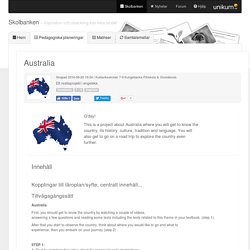
Tillvägagångssätt Australia First, you should get to know the country by watching a couple of videos,answering a few questions and reading some texts including the texts related to this theme in your textbook. (step 1). After that you start to observe the country, think about where you would like to go and what toexperience, then you embark on your journey (step 2) . STEP 1:A. Then answer these questions – write the answers on your ”lärlogg”: 1. B. C. . – yet again, write on your ”lärlogg”.1. D. E. STEP 2:You are going to embark on a 30-day road trip around Australia. START with you arriving at Canberra Airport in the capital of Canberra.
Some pages where you can find useful information:Travel guides: Tourist Commission: Australia. V37Vi börjar att prata om Australien..
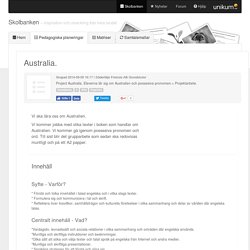
Vad vet vi redan. Läser kap.2a och pratar om Waltzing Matilda. Bedömningsmatris för "Project Australia" Australia Day. Australian animals and birds are favourites with children the world over, and here you can learn a...
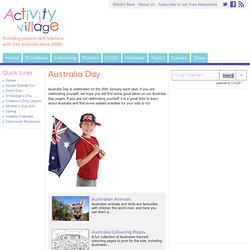
A fun collection of Australian themed colouring pages to print for the kids, including Australian... Just for Australia Day, enjoy these fun Australia Day colouring pages for younger children, showing... Celebrate Australia Day with the help of our Australia Day printables. We've got all sorts here,... Australia. Australia's ecosystem is an unusual one because of its remote location.
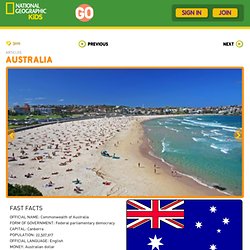
As a result, there are many animal species that occur here and nowhere else in the world, such as the platypus, kangaroo, echidna, and koala. Australia has 516 national parks to protect its unique plants and animals. One of Australia's most amazing sites rises like an enormous whale's back from a flat red-soil desert called the Red Center. This site is called Uluru, and it is a sacred natural formation at the heart of the country. Australia map colouring page. Australia. Australia Facts for Kids: Facts about Australia for Kids. Interesting Facts for Kids Here are some interesting Australia Facts which were chosen and researched by kids especially for kids.

Australia Day. Australia Day is celebrated annually on January the 26th.
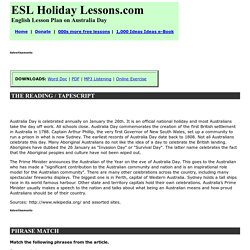
It is an official national holiday and most Australians take the day off work. All schools close. Australia Day commemorates the creation of the first British settlement in Australia in 1788. Captain Arthur Phillip, the very first Governor of New South Wales, set up a community to run a prison in what is now Sydney. 25 Facts About Australia That Show Why It’s So Unique.
Come to Australia [Comedy Song] Anaconda Society: Australia - UR Skola. Come to Australia [Comedy Song] City WebQuests: Sydney. This webquest will help you investigate Sydney: its history, music and famous landmarks.
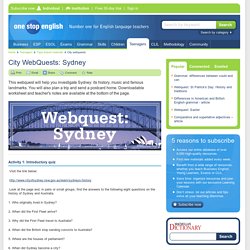
You will also plan a trip and send a postcard home. Downloadable worksheet and teacher's notes are available at the bottom of the page. Activity 1: Introductory quiz. Migration Museum. Norfolk Island. Norfolk Island ( i/ˈnɔrfək ˈaɪlənd/; Norfuk: Norf'k Ailen[4]) is a small island in the Pacific Ocean located between Australia, New Zealand and New Caledonia, 1,412 kilometres (877 mi) directly east of mainland Australia's Evans Head, and about 900 kilometres (560 mi) from Lord Howe Island.
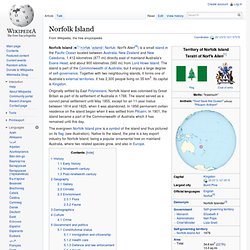
The island is part of the Commonwealth of Australia, but it enjoys a large degree of self-governance. Together with two neighbouring islands, it forms one of Australia's external territories. It has 2,300 people living on 35 km2. Its capital is Kingston. Ndla. School education. Learn About Australia. Australia: Background Australia is both a country and a continent.
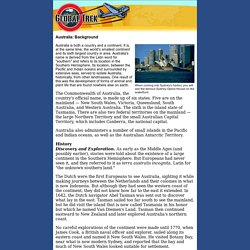
It is, at the same time, the world's smallest continent and its sixth largest country in area. Australia's name is derived from the Latin word for "southern" and refers to its location in the Southern Hemisphere. Australia Country Profile. State Records of South Australia - Home Page. Trapped - Australian TV Series s01e01. Australia Theme - Lesson Plans, Thematic Units, Printables, Worksheets. Australia - the land down under. Aboriginal Australia: History, Culture, and Conflict.
Aboriginal AustraliaHistory and culture of Australia's indigenous peoples Who Are Aborigines?
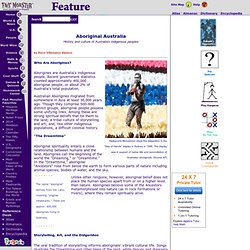
Aborigines are Australia's indigenous people. Recent government statistics counted approximately 400,000 aboriginal people, or about 2% of Australia's total population. Australian Aborigines migrated from somewhere in Asia at least 30,000 years ago. Though they comprise 500–600 distinct groups, aboriginal people possess some unifying links. "The Dreamtime" Aboriginal spirituality entails a close relationship between humans and the land.
Unlike other religions, however, aboriginal belief does not place the human species apart from or on a higher level than nature. Coral Sea Islands. Map of the Coral Sea Islands Map of the Coral Sea Islands Territory History[edit] The Coral Sea Islands were first charted in 1803; in the 1870 and 1880s the islands were mined for guano but the absence of a permanent supply of fresh water prevented long-term habitation.[1] The territory was created in 1969 by the Coral Sea Islands Act (before, the area was considered part of Queensland) and extended in 1997 to include Elizabeth and Middleton Reefs nearly 800 km further South, already in the Tasman Sea. Visit Australia - Travel & Tour Information. Australia country profile. Australia ranks as one of the best countries to live in the world by international comparisons of wealth, education, health and quality of life.
The sixth-largest country by land mass, its population is comparatively small with most people living around the eastern and south-eastern coastlines. The country's first inhabitants, the Aboriginal people, are believed to have migrated from Asia tens of thousands of years before the arrival of British settlers in 1788. They now make up less than 3% of Australia's 23 million people. Years of mass immigration after the Second World War heralded sweeping demographic changes, making modern Australia one of the world's most multicultural countries. But migration continues to be a sensitive issue politically. Australia Map / Map of Australia - Facts, Geography, History of Australia. Australia whose name comes from the Latin word australis, meaning "southern", has a population of 23,480,939 and gained its independence in 1918.
The initial inhabitants of Australia traveled here from far-southeast Asia, and from the Torres Strait islands. From their initial settlements in the north some 70,000 years ago, their individual lifestyles and cultural traditions eventually spread across this vast uncharted land. The first European exposure to Australia occurred in 1606, when the Dutch explorer, Willem Janszoon, sighted, then landed on the Cape York Peninsula. He found the area inhospitable and moved on. Regardless, adventurers and traders, aggressively searching for riches in the southern hemisphere, continued to sail through the northern coastal areas bordering a land the Dutch named New Holland.
Australian Culture Guide - Exploring Australia Through Culture, Tourism, Inspirational Stories, Poetry and Facts. Australian Holidays & Travel Information - Tourism Australia. Christmas Island. Coordinates: The Territory of Christmas Island is a territory of Australia in the Indian Ocean. It has a population of 2,072 residents who live in a number of "Settlement areas" on the northern tip of the island: Flying Fish Cove (also known as Kampong), Silver City, Poon Saan, and Drumsite.
The majority of the population is Chinese Australian. It is called Christmas Island because it was discovered on Christmas Day. The island's geographic isolation and history of minimal human disturbance has led to a high level of endemism among its flora and fauna, which is of significant interest to scientists and naturalists.[2] 63% of its 135 square kilometres (52 sq mi) is an Australian national park. Phosphate, deposited originally as guano, has been mined on the island for many years.
History[edit] First visit by Europeans[edit] States and territories of Australia. All states and two of the three internal territories have their own parliaments and administer themselves; all remaining territories are administered by the federal government, but with Norfolk Island having some degree of self-government. Map showing the creation of the colonies/states and mainland territories. States and territories[edit] See also: List of State Codes Australia has had three now-defunct territories in its history: From 1926 to 1931, the Northern Territory was divided into Central Australia and North Australia, with the border at the 20th parallel of latitude.
Background and overview[edit] The states originated as separate British colonies prior to Federation (in 1901). Visit Australia – Travel & Tour Information – Tourism Australia. Australian Capital Territory. Australian Capital Territory (abbreviated ACT) (formerly, "The Territory for the Seat of Government" and, later, the "Federal Capital Territory") is a territory in the south east of Australia, enclaved within New South Wales.
It is the smallest self-governing internal territory in Australia. Access VG1: Whale Rider / Ta Moko. Aboriginal Australia: History, Culture, and Conflict. Maorierna - Nya Zeelands stolta urbefolkning. Whale Rider (2002)
The Whale Rider. MAORI. Map. Racism. Animals. Maralinga. TV-series/Films. Music. Welcome to Australia (video 8,35 min) Eslteacher- Most important English speaking Countries. How to speak Australian : Abbreviate Everything. Aboriginal Australia: History, Culture, and Conflict. BBC Learning English - Course: Towards Advanced / Unit 22 / Session 2 / Activity 1. The Outback @ Warrawagine Cattle Co. Anaconda Society: Australia. Australian History.
Australian Climate video. Indigenous Australia on ASO. Dust Echoes: Ancient Stories, New Voices. Australia: Fears Over New 'Stolen Generation' By Jonathan Samuels, Australia Correspondent Campaigners are asking for the law to be changed to help rescue thousands of Aboriginal children in Australia from extreme neglect. Alcohol abuse is rife amongst indigenous communities and children are being abandoned while their parents drink. In some rural areas it is common to see toddlers in nappies wandering around unsupervised, even begging for food or warm clothing. Many non-indigenous families are so concerned that they have been taking children off the streets and into their homes without formal permission. They want the law changed to make it easier for white Australians to foster or adopt Aboriginal children. Eight-year-old Cebby, who was born to an alcoholic mother, has been surrounded by alcohol abuse and violence throughout his young life.
He told Sky News about the few simple things he thinks adults should provide. "I want them to make me feel safe. The community of Tennant Creek is seeing hundreds of abandoned children. Access VG1: Aboriginal Australians.